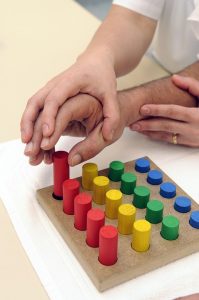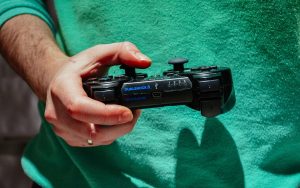Training improves task performance due to improved motor control through practice. Intriguingly, training with one limb can improve task performance with the other, untrained limb. This phenomenon is known as interlimb transfer or cross education, and it is important for rehabilitation when the most affected limb cannot engage in training (Ruddy and Carson 2013). Ample evidence of this phenomenon exists. However, the phenomenon seems to be most prevalent in the early phase of skill learning (Boutin et al. 2012), and this may limit its clinical significance.
In our recent study (Christiansen et al. 2017), we investigated if progressive motor skill training was more effective than non-progressive training at inducing the interlimb transfer effect. Twenty-three healthy participants played a classic arcade game (“Breakout”) with their dominant, right hand for 6 weeks (3 training sessions per week, 30 minutes per session). Twelve of the participants performed progressive training, in which game difficulty was gradually increased throughout the 6 week period. The other 11 participants performed non-progressive training, in which game difficulty remained the same over the 6 weeks. Before and immediately after the 6 week period, we measured how well participants could play the game with their right and left hands. The left hand was considered the “untrained hand” because it was not involved in the training. Also, to identify changes in the central nervous system with skill learning, we used non-invasive brain stimulation (transcranial magnetic stimulation) to monitor changes in corticospinal excitability of the neural connections between the brain and the muscles of the untrained hand. Moreover, to assess retention of task performance and corticospinal excitability, we acquired measurements 8 days and 1 year after training was completed.
WHAT DID WE FIND?
Compared to non-progressive training, progressive training led to larger improvements in task performance for the trained and untrained hands. Immediately after the 6 week period, task performance in the untrained hand was 63% better in the group that performed progressive training, and it was 75% better when assessed 8 days after training finished. However, there was no difference between the two groups when task performance of the untrained hand was measured one year after training.
For both progressive and non-progressive training, corticospinal excitability increased after the first training session, but only progressive training was associated with increased excitability throughout the 6 weeks of training and 8 days after the training finished. When tested a year after training finished, no differences in corticospinal excitability to the untrained hand were present between the two groups.
SIGNIFICANCE AND IMPLICATIONS
Our findings imply that skill improvement of the untrained hand is driven by changes in the central nervous system which take place when the participant is challenged with training that becomes progressively more difficult over a given training period. However, the accompanying behavioral benefits and neurophysiological effects disappear when training is discontinued. This underlines the importance of closely monitoring the proficiency and performance of patients in early neurorehabilitation and progressively adjusting the difficulty of their exercises.
PUBLICATION REFERENCE
Christiansen L, Larsen MN, Grey MJ, Nielsen JB, Lundbye-Jensen J. Long‐term progressive motor skill training enhances corticospinal excitability for the ipsilateral hemisphere and motor performance of the untrained hand. Eur J Neurosci 45: 1490-1500, 2017.
KEY REFERENCES
Boutin A, Badets A, Salesse RN, Fries U, Panzer S, Blandin Y. Practice makes transfer of motor skills imperfect. Psychol Res 76: 611-625, 2012.
Ruddy KL, Carson RG. Neural pathways mediating cross education of motor function. Front Hum Neurosci 7: 2013.
AUTHOR BIO
 Lasse Christiansen is a research fellow at the Miami Project to Cure Paralysis at the University of Miami. Lasse uses non-invasive brain stimulation to explore the mechanisms underlying changes in motor control. He also researches new neuromodulatory strategies to improve motor function in patients with spinal cord injury.
Lasse Christiansen is a research fellow at the Miami Project to Cure Paralysis at the University of Miami. Lasse uses non-invasive brain stimulation to explore the mechanisms underlying changes in motor control. He also researches new neuromodulatory strategies to improve motor function in patients with spinal cord injury.


Hi there ,
I’m eager to know more about treatment programs /transcranial magnetic stimulation in regards to my cerebral palsy-specifically my right hand/wrist with interest in increased movement/function after a tendon transfer Surgury
I’m a 35 year old female
Hi Nicole,
Thanks for your continued interest in the blog.
Currently, it is unknown if transcranial magnetic stimulation can improve hand function in those with (or without) cerebral palsy.
Sincerely,
MI blog administrators
I would like to know more and keen about being a participant in a program for myself if this is effective for a 35 yr old female with cerebral palsy ,affecting right side , especially right hand /wrist looking at increased movement /function
Hi Nicole,
Thanks for your interest in the blog. We think it is great that you are attempting to apply the study’s findings to your personal health.
One thing to note is that the study involved participants with no underlying neurological conditions. So, we are unsure if the same results would occur in someone with cerebral palsy.
We are unable to provide direct medical advice. However, you could make your physiotherapist (physical therapist) aware of the study’s findings and get their opinion. The “cross-education” effect—the phenomenon where training a limb on one side of the body improves motor function and muscle strength of the other limb—is well-established in the scientific literature. It’s practical significance is still not entirely clear, but it is something your physiotherapist should be aware of. We are just unsure how it might apply to your particular set of circumstances.
Sincerely,
MI blog administrators